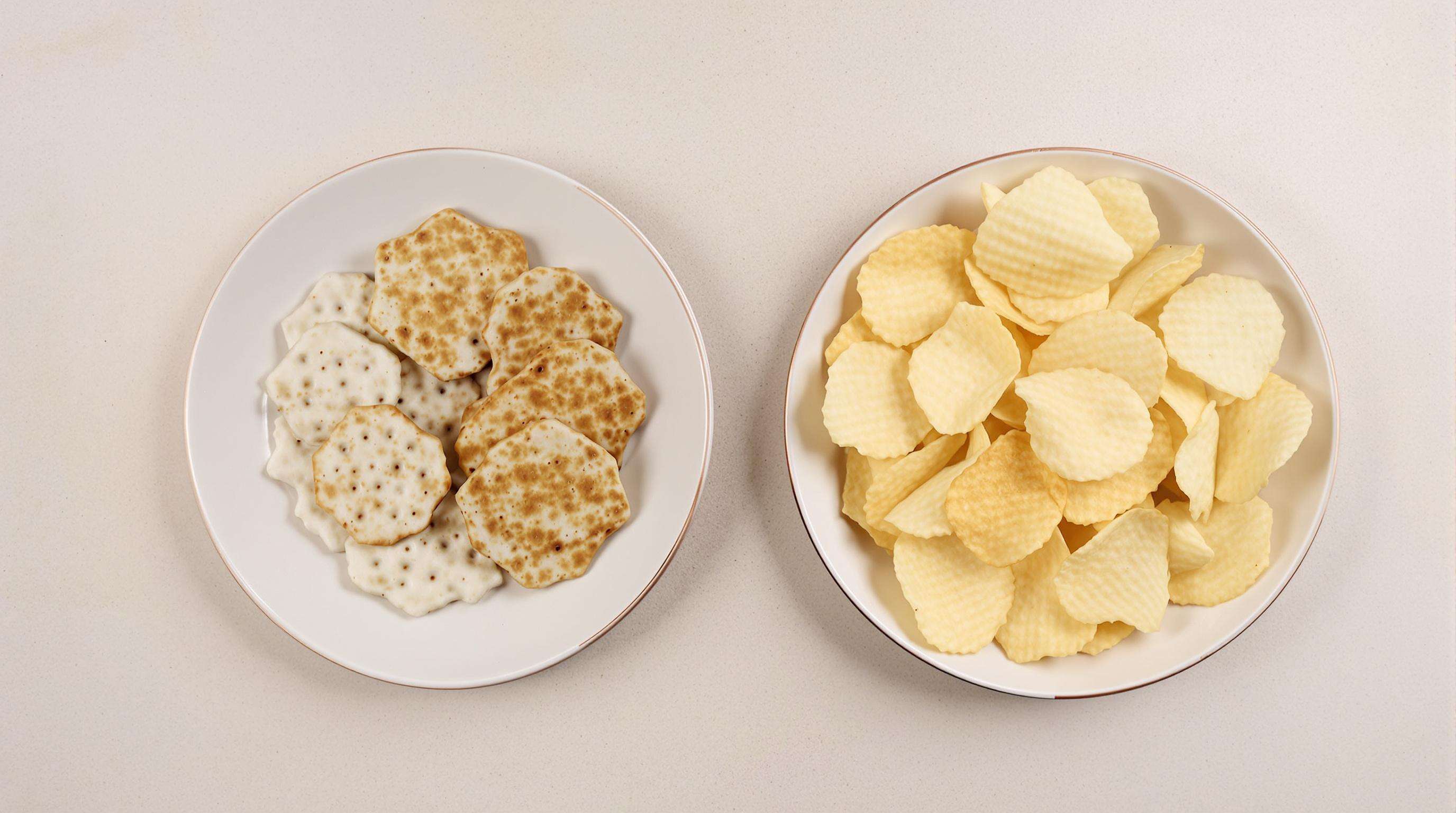The market for Asian inspired snacks in Western countries has grown quite a bit lately according to Nielsen data from 2023 showing a 27% increase year over year. Younger folks especially seem drawn to these snacks because they offer strong flavors and interesting textures that stand out from regular store bought options. Take senbei rice crackers for instance. These traditional Japanese snacks are basically just rice, salt, and seaweed pressed together but somehow manage to be really popular right now among people looking for something different. A recent survey in 2023 revealed that about two thirds of American millennials actually look for what they call 'culinary adventures' when picking snacks. Not surprisingly, grocery stores have responded by making their ethnic food sections bigger too. Retailers expanded those areas by around 18% between 2021 and now as they try to keep up with changing consumer tastes.
Senbei has a pretty straightforward ingredient list usually just rice, soy sauce, and some seaweed which fits right into the current trend toward snacks with clean labels. According to Innova's data from 2024, more than half of all consumers around the world are looking for plant based foods these days. That makes senbei an attractive option compared to regular potato chips since it's naturally vegan without any fancy labeling required. Plus, there aren't any artificial stuff added in either, something that matters a lot to people worried about eating too many ultra processed foods. Euromonitor reports this concern affects about 41% of shoppers in Europe alone as of 2023.
Since 2020, Japanese companies have really expanded their presence in American stores, doubling down on partnerships so that popular brands can now be found in around 12 thousand locations across the country. The rise of online shopping has definitely helped things along too. Sales of senbei online jumped nearly 90 percent between 2021 and 2023, mostly because people started buying them through subscription snack services and Amazon's growing food business worldwide. Working with smaller specialty shops has also changed how consumers see these traditional snacks. Now there are fancy versions selling for anywhere from 30 to almost half again what regular store bought ones cost, which tells us something about changing tastes and willingness to pay more for quality.
Ethnic snack sales are expected to climb around 7.2 percent annually until 2028 according to Grand View Research's latest data. Flavors packed with umami such as wasabi and yuzu are gaining ground faster than old favorites like cheese and barbecue in markets where novelty matters most. Take senbei for instance it appears on shelves at roughly 23% of US specialty food shops these days, compared to just 9% back in 2019 per the Global Snack Culture Report findings. What we're seeing here isn't just numbers going up but actual changes in what people want when they grab a quick bite between meals.

Senbei makes for a healthier snack option compared to regular potato chips, cutting down on calories by around 35 to 50 percent in most servings. Plus, it packs about 3 to 5 grams of fiber per 100 grams, which helps keep people feeling full longer and supports better digestion. According to Zenmarket's 2023 report, nearly three quarters of people worldwide are looking for snacks that won't pack on the pounds. That makes sense when we think about how many folks struggle with their weight these days. What sets senbei apart from those processed wheat crackers is its base made from whole grain rice. The complex carbs in rice give the body steady fuel throughout the day instead of causing those energy crashes we get from simpler carbohydrates.
About one out of every five people these days are looking for foods without gluten according to Market Research Intellect from last year. That's why senbei works so well for folks who need to avoid certain ingredients. Made mostly from rice, seaweed, and simple seasonings, this snack fits right into what many call clean eating or vegan lifestyles too. The combination of being both gluten free and made with natural stuff has really boosted sales across borders. Exports to places like North America and Europe jumped by around 22 percent after 2021 as more shoppers discovered what makes senbei special beyond just taste.
| Attribute | Senbei Rice Crackers | Traditional Potato Chips |
|---|---|---|
| Fat Content | 1–3g per 100g | 35–40g per 100g |
| Cooking Method | Roasted/Baked | Deep-Fried |
| Additives | 0–2 ingredients | 5–8 preservatives |
| Glycemic Index | Medium (56–69) | High (70–85) |
The baked preparation preserves nutritional integrity and avoids trans fats common in fried snacks. This edge enables senbei brands to tap into the $23.6 billion healthier snack market projected for 2025.
Today's snack lovers want something both fresh and genuine at the same time. Senbei makers got this message loud and clear, so they started rolling out all sorts of creative flavors these days. Think wasabi mixed right in, cracker surfaces dusted with seaweed, or those sweet and salty miso coatings everyone seems to love lately. What makes these work is how they keep that satisfying crunch we all know from regular senbei but throw in some seriously interesting tastes. According to a recent look at the snack market from earlier this year, around 38 out of every 100 new Asian snacks appearing on shelves across American stores were actually these fusion style senbei products. That beats out the old school soy sauce versions pretty handily.
The umami factor, which is considered the fifth basic taste, really sets apart good senbei from the rest. Manufacturers are getting creative with stuff like dried fish flakes and aged soy products to create that deep, savory flavor profile that draws in people who love bold tastes as well as those watching what they eat. According to some research from the International Food Council back in 2023, around two thirds of folks worldwide actually favor these kinds of complex savory flavors instead of going for sweet stuff anymore. Makes sense when you think about it.
Japanese producers are tailoring flavors to regional palates without sacrificing authenticity. In the UK, yuzu-chili senbei saw a 210% year-over-year sales increase in Q1 2024 (Nielsen retail data), thanks to its balance of citrus brightness and mild heat–a profile that resonates with European preferences for tangy-spicy snacks.
Small-batch techniques and seasonal flavors–such as cherry blossom or black sesame–have repositioned senbei as a gourmet experience. Limited-edition releases command 3–5x higher price points than standard versions, with retailers reporting sell-through rates above 85%, demonstrating the effectiveness of scarcity-driven marketing.

Senbei is made using old fashioned techniques that involve very little processing and stick to natural ingredients throughout. The traditional way works something like this: they take rice flour that's been ground on stones, mix it with water, then steam everything together. This helps keep most of the nutrients intact while steering clear of any artificial stuff. These days, companies making senbei have started incorporating better technology that saves energy. Some reports show water consumption has dropped around 30 percent when compared to how other snack foods get produced. And speaking of what people want these days, lots of folks care about going green. About two thirds of those environmentally minded customers actually look for snacks wrapped in materials that can be recycled or broken down naturally.
Senbei makers in Japan get a real edge when they source their short grain rice locally, which brings down their carbon footprint by about 15% compared to what happens with imported stuff. Around the world, companies are getting creative with where they get their ingredients these days. Take the US market for example, roughly 40% of senbei products there mix local rice crops with traditional Japanese varieties so they can keep that authentic taste without completely sacrificing green credentials. According to a recent look at supply chains back in 2024, simply getting ingredients from nearby areas manages to slash transport related emissions by nearly a quarter. And let's not forget about those water saving techniques being used across parts of Southeast Asia either. These practices help cut down on overall environmental damage, making it possible for businesses to grow responsibly without breaking the bank or harming nature too badly along the way.
Adapting senbei for international audiences presents quite a puzzle for brands trying to enter new markets. Traditional flavors such as soy sauce and nori definitely hold onto their authentic Japanese roots, but many Western buyers are now gravitating toward local twists on these classic snacks. Think spicy chili-lime mixes or even truffle versions that blend East meets West. According to the latest Snack Industry Trend Report from 2023, nearly 7 out of 10 global snack introductions last year featured some kind of flavor mashup. But there's a catch here too much experimentation might actually water down what makes senbei special in the first place its deep connection to Japanese culture and tradition.
The traditional ways of making premium senbei involve things like hand pressing and charcoal grilling, which gives them their special character but makes it hard to scale up production. One skilled craftsman can manage around 200 to maybe 300 crackers an hour at most, while machines in big factories can crank out over 15 thousand units in the same time frame. According to Nielsen data from last year, about 42 percent of people in America actually want to spend extra money on these craft snacks. However there's another problem nobody talks about much the rice crackers are super sensitive to humidity changes, making shipping them across country something of a logistical nightmare for manufacturers.
Despite having a 23% lower glycemic index than wheat crackers (Journal of Nutritional Science 2024), 61% of European consumers associate “rice-based” with “high-carb” snacks. Clear messaging around senbei’s 2.3g fiber per serving and gluten-free certification is essential to overcoming these misconceptions in health- and sugar-conscious markets.
Senbei rice crackers are traditional Japanese snacks made primarily from rice, soy sauce, and seaweed, offering crunchy textures and unique flavors.
Senbei rice crackers are gaining popularity due to their clean label, plant-based ingredients, and the growing interest in ethnic and fusion flavors globally.
Yes, Senbei rice crackers are considered healthier than traditional fried snacks like potato chips due to their lower calorie and fat content and high fiber content.
Yes, Senbei rice crackers are gluten-free and suitable for individuals with gluten intolerance or celiac disease.
Senbei rice crackers production uses minimal processing and eco-friendly ingredients, reducing water consumption and carbon footprint.
 Hot News
Hot News